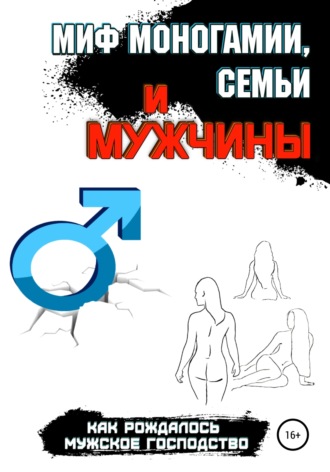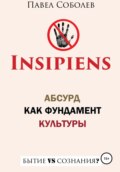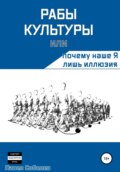
Павел Соболев
Миф моногамии, семьи и мужчины: как рождалось мужское господство
Шадрина А. Дорогие дети: сокращение рождаемости и рост «цены» материнства в XXI веке. – М.: НЛО, 2017.
Шашков С. История русской женщины. – СПб., 1879.
Шестаков Д. А. Семейная криминология: Криминофамилистика (2-е изд.) – СПб.: Юридический центр Пресс, 2003.
Шестов Л. Преодоление самоочевидностей // Шестов Л. Сочинения в 2-х т. – М.: «Наука», Том 2, 1993.
Шипов Б. Великая ложь. Теория любви: мифы и реальность. – Самара: Бахрах-М, 2010.
Шкуратов В. А. Историческая психология. Уч. пос. изд. 2. – М., 1997.
Шлюмбом Ю. Устойчивые мифы и изменчивые практики: "Крестьянский двор" и большая семья в Германии / Homo Historicus: к 80-летию со дня рождения Ю. Л. Бессмертного: В 2 кн. / Ред. А. О. Чубарьян. – М.: Наука, 2003, Кн. 1. – с. 631–649.
Шлюмбом Ю. Детство в Германии: проблемы социализации и воспитания в 1700–1850 гг. // Гендер и общество в истории. – СПб.: Алетейя, 2007.
Шнейдер Л. Б. Семья: оглядываясь вперёд. – Изд-во: «Питер», 2013.
Шнирельман В.А. Происхождение скотоводства. – М.: Наука, 1980.
Шнирельман В. А. Парадоксы половых ролей // Советская этнография, 1990, № 6, с. 55–61.
Шнирельман В. А. У истоков войны и мира // Война и мир в ранней истории человечества. В 2-х т. Т.1. – М.: Институт этнологии и антропологии РАН, 1994.
Шпренгер Я., Инститорис Г. Молот ведьм. – Саранск: Норд, 1991.
Щапов Я. Н. Государство и церковь в Древней Руси X–XIII вв. М.: Наука, 1989.
Щапов Я. Н.Очерки русской истории, источниковедения, археографии. – М.: Наука, 2004.
Эйдемиллер Э. Г., Юстицкис В. Психология и психотерапия семьи. 4-е изд. – СПб.: Питер, 2008.
Эльконин Б. Д. Введение в психологию развития. В традиции культурно-исторической теории Л. С. Выготского. – М.: Тривола, 1994.
Эльконинова Л. И., Эльконин Б. Д. Знаковое опосредование, волшебная сказка и субъектность действия // Психология игры и сказки. Хрестоматия. – М.: АНО "Психологическая электронная библиотека", 2008.
Энгельс Ф. Полю Лафаргу // К. Маркс и Ф. Энгельс: сочинения, изд. 2, Т. 36. – М.: изд-во политической литературы, 1964.
Энгельс Ф. Происхождение семьи, частной собственности и государства // К. Маркс и Ф. Энгельс: сочинения, изд. 2, Т. 21. – М.: изд-во политической литературы, 1961.
Эриксен Т. Х. Что такое антропология? – М.: Изд. дом Высшей школы экономики, 2014.
Эриксон Э. Детство и общество. – М.: Прогресс книга, 2019.
Юссен Б. Родство искусственное и естественное? Биологизмы в культурно-исторических концепциях родства // Человек и его близкие на Западе и Востоке Европы (до начала нового времени). – М., ИВИ РАН, 2000.
Ялом И. Когда Ницше плакал. – М.: Изд-во ЭКСМО-Пресс, 2001.
Ялом М. История жены. – М.: Новое литературное обозрение, 2019.
Япко М. Депрессия заразительна. – СПб.: Питер, 2013.
Ясперс К. Духовная ситуация времени // Призрак толпы / Карл Ясперс, Жан Бодрийар. М.: Алгоритм, 2008
Ястребицкая А. Л. Представления людей Средневековья о семье, браке, сексуальной морали // Культура и общество в Средние века: реферативный сборник – М.: 1982.
Ястребицкая А. Л. Семья в средневековом городе // ВИ. 1985. № 8, с. 68–71.
Abdollahi, F., Lye, Munn-Sann, Zain, A., Ghazali, S. S., Zarghami, M. (2011). Postnatal Depression and Its Associated Factors in Women From Different Cultures // Iran J Psychiatry Behav Sci., Autumn-Winter; 5(2): 5–11.
Alesina, A., Di Tella, R. & MacCulloch, R. (2004). Inequality and happiness: Are Europeans and American different? Journal of Public Economics, 88, 2009–2042.
Alexander M. G. & Fisher T. D. (2003). Truth and consequences: using the bogus pipeline to examine sex differences in self-reported sexuality // Journal of sex research, 40, 27–35.
Alexander, G. M., Sherwin, В.B. (1991). The association between testosterone, sexual arousal, and selective attention for erotic stimuli in men. Hormones and Behavior, 25(3), 367–381.
Arabagian, R.K. (1984). Cattle raiding and bride stealing: the goddess in Indo-European heroic literature // Religion, 14:2, 107-142.
Arora M. K., Yadav A., Saini V. Role of hormones in acne vulgaris. ClinBiochem. 2011 Sep;44(13):1035–1040.
Aukett, R., Ritchie, J., & Mill, K. (1988). Gender differences in friendship patterns. Sex Roles, 79(1–2), 57–66.
Bajos N., Bozon M., Beltzer N. Enquetes sur la sexualite en France. – La Decouverte, INED, 2008.
Balter M. 2010. Score One for Hunting at Olduvai // Science. V 329, pp. 1464–1465.
Bancroft J. (1984). Hormones and human sexual behavior. Journal of sex and marital therapy, 10, 3–21.
Bancroft J. (2002). Biological factors in human sexuality, The Journal of Sex Research, 39:1, 15–21.
Bancroft J, Sanders D, Davidson D, Warner P. Mood, sexuality, hormones and the menstrual cycle: 111. Sexuality and the role of androgens. Psychosom Med 45(6):509ff, 1983.
Bank, В.J. & Hansford, S. L. (2000). Gender and friendship: Why are men’s best same-sex friendships less intimate and supportive? Personal relationships, 7, 63–78.
Barnes, R.H. Marriage by Capture // The Journal of the Royal Anthropological Institute, Vol. 5, No. 1 (Mar., 1999), pp. 57-73.
Barrett, М., Mclntosh, М. (1982) The Anti-Social Family. London: Verso.
Bartlett, L. J., Williams, D. R., Prescott, G. W. et al. (2015) Robustness despite uncertainty: regional climate data reveal the dominant role of humans in explaining global extinctions of Late Quaternary megafauna // Ecography (https://doi.org/10.1111/ecog.01566).
Beckerman, S., Valentine, P., (eds) (2002) The Theory and Practice of Partible Paternity in South America, University Press of Florida.
Beidelman Т. О. Pig (Guluwe): An Essay on Ngulu Sexual Symbolism and Ceremony // Southwestern Journal of Anthropology, Vol. 20, No. 4 (1964): 375.
Bell C. J., Foulds J. A., Horwood L. J., Mulder R. T. Childhood abuse and psychotic experiences in adulthood: findings from a 35-year longitudinal study // The British Journal of Psychiatry, 27 November 2018, или https://doi.org/10.1192/bjp.2018.264
Belsky J., Lang M. E., Rovine M. Stability and change in marriage across the transition to parenthood: A second study // Journal of Marriage and the Family. 1985. N. 47. P. 855–865.
Belsky, J., and M. Rovine. Patterns of Marital Change across the Transition to Parenthood: Pregnancy to Three Years Postpartum // Journal of Marriage & Family, 52 (1990): 5–19.
Belsky, J., and J. Kelly. The Transition to Parenthood: How a First Child Changes a Marriage and Why Some Couples Grow Closer and Others Apart. New York: Dell, 1994.
Berardo, F. M. (1970). Survivorship and social isolation: The case of the aged widower // The Family Coordinator, 79(1), 11–25.
Berkowitz, B., Yager-Berkowitz, S. He’s Just Not Up For It Anymore: Why Men Stop Having Sex and What You Can Do About It. – New York: William Morrow, 2008.
Bernard, J. (1972). The Future of Marriage. – New York: Bantam Books.
Berndt, C. H. and R. M. Berndt, 1951. Sexual Behaviour in Western Arnhem Land.Viking Fund Publications in Anthropology, 16. New York: Wenner-Gren.
Bertschinger, H., Delsink, A. et al. (2008). Reproductive control of elephants // Elephant management. A scientific assessment for South Africa. – Wits University Press, Johannesburg, pp.257–328.
Bhattacharya K, Ghosh A, Monsivais D, Dunbar RIM, Kaski K. (2016), Sex differences in social focus across the life cycle in humans" // Royal Society Open Science. 2016 Apr; 3 (4).
Bird-David, N. (1990). The giving environment: Another perspective on the economic system of gatherer-hunters // Current Anthropology 31(2):189–196.
Birditt, K. S., Wan, W. H., Orbuch, T. L., & Antonucci, T. C. (2017). The development of marital tension: Implications for divorce among married couples. Developmental Psychology, 53(10), 1995–2006.
Bischof, N. (1975): Comparative Ethology of Incest Avoidance // Biosocial Anthropology. – London: Malaby Press. pp. 37–67.
Bleek, D.F. The Naron: A Bushman Tribe of the Central Kalahari, 1928.
Boesch C. The Effects of Leopard Predation on Grouping Patterns in Forest Chimpanzees // Behaviour. 1991. No. 117. P. 220–242.
Boesch C., Bole C., Eckhardt N., Boesch H. Altruism in Forest Chimpanzees: The Case of Adoption // PLoS ONE, 2010.
Bossen, L., Gates, H. Bound Feet, Young Hands: Tracking the Demise of Footbinding in Village China. – Stanford University Press, 2017.
Bradbury, T. N., Fincham F. D., & Beach S. R. H. (2000). Research on the nature and determinants of marital satisfaction: A decade in review. Journal of Marriage and Family, 62, 964–980.
Brewis, A., & Meyer, M. (2005). Demographic evidence that human ovulation is undetectable (at least in pair bonds) // Current Anthropology, 46 (3), 465–471.
Bridges, L. (1948). Uttermost Part of the Earth – London, Hodder & Stoughton.
Brinig, M. F., Allen, D. W. (2000). These Boots are Made for Walking': Why Most Divorce Filers are Women // American Law and Economics Review, Vol. 2, pp. 126–169.
Brotto, L. A., Petkau, A. J., Labrie, F., and Basson, R. Predictors of Sexual Desire Disorders in Women. Journal of Sexual Medicine 8 (2011): 742–53.
Brown, M. J., Satterthwaite-Phillips, D. (2018) Economic correlates of footbinding: Implications for the importance of Chinese daughters’ labor // PLoS ONE 13(9): e0201337.
Brown, R. E. Sexual arousal, the Coolidge effect and dominance in the rat (Rattus norvegicus) // Animal Behaviour. – 1974. – № 22. – P. 634–637.
Bruner, A., Revuski, S. 1961, Collateral behavior in humans // Journal of Experimental Analysis of Behavior, 4, 349–350.
Burt, A. (1992). Concealed ovulation' and sexual signals in primates // Folia Primatologica. 58 (1): 1–6.
Byers, S. & Heinlein, L. Predicting Initiations and Refusals of Sexual Activities in Married and Cohabiting Heterosexual Couples // The Journal of Sex Research, Vol. 26, No. 2 (May, 1989), pp. 210–231.
Call, V., Sprecher, S., & Schwartz, P. (1995). The incidence and frequency of marital sex in a national sample. Journal of Marriage and the Family, 57(3), 639–652.
Campos-Castillo, C., Shuster, S. M., Groh, S. M., Anthony, D. L. Warning: Hegemonic Masculinity May Not Matter as Much as You Think for Confidant Patterns among Older Men // Sex Roles: A Journal of Research, 2020.
Carr, D. (2004). The Desire to Date and Remarry Among Older Widows and Widowers // Journal of Marriage and Family 66(4): 1051–1068.
Carr, D., Freedman, V. A., Cornman, J. C., Schwarz, N. (2014). Happy Marriage, Happy Life? Marital Quality and Subjective Well?being in Later Life // Journal of Marriage and Family, V. 76, Issue 5, pp. 930–948.
Carroll, J. L., Volk, K. D., & Hyde, J. S. (1985). Differences between males and females in motives for engaging in sexual intercourse // Archives of Sexual Behavior, 14(2), 131–139.
Carsten J. Cultures of Relatedness: new approaches to the study of kinship, Cambridge: Cambridge University Press, 2000.
Cassels, M. T., White, N., Gee, N., Hughes, C. (2017). One of the family? Measuring young adolescents' relationships with pets and siblings // Journal of Applied Developmental Psychology, Volume 49, pp. 12–20.
Chafe W. The Paradox of Change: American Women in the 20th Century – New York: Oxford University Press, 1991.
Chao, F., Gerland, P., Cook, A. R., Alkema, L. Systematic assessment of the sex ratio at birth for all countries and estimation of national imbalances and regional reference levels // PNAS May 7, 2019 116 (19) 9303–9311.
Chapais, B. Primeval kinship: how pair-bonding gave birth to human society. – Harvard University Press, Cambridge, 2008.
Chapais, В., Mignault, С. (1991). Homosexual incest avoidance among females in captive Japanese macaques // American Journal of Primatology, 23, pp. 171–183.
Chapman, S. N., Pettay, J. E., Lummaa, V., Lahdenpera, M. (2019). Limits to Fitness Benefits of Prolonged Post-reproductive Lifespan in Women // Current Biology, volume 29, issue 4, pp. 645–650.
Chivers M. L., Rieger G., Latty E. & Bailey J. M. (2004). A sex difference in the specificity of sexual arousal // Psychological Science, 15, 736–744.
Chivers M. L., Seto M. C., Blanchard R. Gender and Sexual Orientation Differences in Sexual Response to Sexual Activities Versus Gender of Actors in Sexual Films // Journal of Personality and Social Psychology, 2007, Vol. 93, No. 6, 1108–1121.
Cho Y. J., Choi R., Park S., Kwon J. Parental smoking and depression, and attention-deficit hyperactivity disorder in children and adolescents: Korean national health and nutrition examination survey 2005–2014 // Asia-Pacific Psychiatry, Volume 10, Issue 3, 2018
Chronis A., Gamble S., Roberts J. E., Pelham W. E. (2006). Cognitive-Behavioral Depression Treatment for Mothers of Children With Attention-Deficit/Hyperactivity Disorder или https://www.ncbi.nlm.nih.gov/pubmed/16942968
Clark, A. E. & Oswald, A. J. (2002). Well-being in panels. Unpublished manuscript, Department of Economics, University of Warwick.
Cohabitation, Marriage, Divorce, and Remarriage in the United States / Centers for Disease Control and Prevention, Vital and Health Statistics, Series 23, Number 22, July 2002.
Cohen, Ph.N. 2014. Family Diversity is the New Normal for America's Children / Council on Contemporary Families Briefing Paper.
Cohen, S. P. Can pets function as family members? // Western Jorn. of Nursing Research. 2002. V. 24. – р. 621–638.
Colla J., Buka S., Harrington D., Murphy J. M. Depression and modernization: a cross-cultural study of women // Soc Psychiatry Psychiatr Epidemiol. 2006 Apr; 41 (4): 271–9.
Collier, J. F., Rosaldo, M. Z. and Yanagisako, S. (1982). Is There a Family?: New Anthropological Views // Rethinking the Family: Some Feminist Questions. B. Thorne and M. Yalom, ed. Pp. 25–39. Longman: New York.
Collins, D. (1798). An account of the English colony in New South Wales – London.
Conaway, C. H., Koford, C. B. (1964). Estrous cycles and mating behavior in a free ranging herd of rhesus monkeys // Journal of Mammalogy, vol. 45, pp. 577-588.
Connidis, I. A. (2001). Family ties and aging. Thousand Oaks, CA: Sage.
Coombs, R. H. (1991). Marital status and personal well-being: A literature review. Family Relations: An Interdisciplinary Journal of Applied Family Studies, 40(1), 97–102.
Coontz, S. Marriage, a History: How Love Conquered Marriage. Penguin, 2006.
Cooper, D., Lane, A. The Death of the Family – The Penguin Press, 1971.
Cowan, P. A., Cowan, C. P. (1989). Changes in marriage during the transition to parenthood: Must we blame the baby? In G. Michaels & W. Goldberg (Eds.), The transition to parenthood: Current theory and research (pp. 114–154). Cambridge, England: Cambridge University Press.
Cowan, P. A., Cowan, C. P., Kline M. (1991). The Origins of Parenting Stress During the Transition to Parenthood: A New Family Model // Early Education and Development, Volume 2, Pages 287–305.
Crabb A. The Wife Drought. – Random House Australia, 2014.
Cucchiari S. The gender revolution and the transition from bisexual horde to patrilocal band: the origins of gender hierarchy // Sexual meanings: The cultural construction of gender and sexuality, 1992, pp. 31–79.
Curie-Cohen M., Yoshihara D., Luttrell L., Benforado K., MacCIuer J. W., Stone W. H. (1983) The effects of dominance on mating behavior and paternity in a captive troop of rhesus monkeys // American Journal of Primatology, Vol. 5; Iss. 2. pp. 127-138.
Curtiss, S. Genie: A Psycholinguistic Study of a Modern-Day "Wild Child". – New York: Academic Press, 1977.
Cutler W. B., Friedmann E., McCoy N. L. Coitus and Menstruation in Perimenopausal Women // Journal of psychosomatic obstetrics and gynecology, 1996 Sep;17(3):149–57.
Dabbs, J. M., & Mohammed. S. (1992). Male and female salivary testosterone concentrations before and after sexual activity Physiology and Behavior, 52(1), 195–197.
Dawson, S. J., Suschinsky, K. D. and Lalumiere, M. L. (2013) Habituation of Sexual Responses in Men and Women: A Test of the Preparation Hypothesis of Women's Genital Responses. J. Sex. Med., 10, 990–1000.
de Waal, F. (1996) Good Natured: The Origins of Right and Wrong in Humans and Other Animals (Harvard Univ. Press, Cambridge, MA).
Delaney J., Lupton M. J., Toth E. The Curse: A Cultural History of Menstruation: 2nd edition – University of Illinois Press, 1988.
Dembler-Stamm T. et al. Sexual Dysfunction in Unmedicated Patients with Schizophrenia and in Healthy Controls. Pharmacopsychiatry. 2018 Jan 29.
DePaulo, B., Morris, W. Singles in Society and in Science // Psychological Inquiry, 2005, Vol. 16, Nos. 2&3, pp. 57–83.
Derrida J. Margins of philosophy. Chicago, 1986.
DeVore, I. (1965). Male dominance and mating behavior in baboons. In F. A. Beach, (Ed.), "Sex and Behavior", J. Wiley & Sons, Inc.
Di Tella, R., MacCulloch, R., & Oswald, A. J. (2003). The macroeconomics of happiness. Review of Economics and Statistics, 85(4), 809–827.
Dittami, J., Keckeis, M., Machatschke, I., Katina, S., Zeitlhofer, J. and Kloesch, G. (2007). Sex Differences in the Reactions to Sleepign in Pairs versus Sleeping Among in Humans // Sleep and Biological Rhythms 5(4): 271–276.
Dong, Y., Morgan, C., Chinenov, Y., Zhou, L., Fan, W., Ma, X., & Pechenkina, K. (2017). Shifting diets and the rise of male-biased inequality on the Central Plains of China during Eastern Zhou // PNAS, 114(5), 932–937.
Doss, B. D., Rhoades, G. K., Stanley, S. M., & Markman, H. J. (2009). The effect of the transition to parenthood on relationship quality: An 8-year prospective study. Journal of Personality and Social Psychology, 96(3), 601–619
Douglas P. H., Hohmann G., Murtagh R., Thiessen-Bock R., Deschner T. Mixed messages: wild female bonobos show high variability in the timing of ovulation in relation to sexual swelling patterns. BMC Evolutionary Biology; 30 June, 2016.
Dykstra, P. A. & Fokkema, T. (2007). Social and Emotional Loneliness Among Divorced and Married Men and Women: Comparing the Deficit and Cognitive Perspectives // Basic and Applied Social Psychology, Volume 29, Issue 1, pp. 1–11.
Eaton, G. G. (1973), Social and endocrine determinants of sexual behaviour in simian and prosimian females // Primate Reproductive Behaviour, Vol. 2 (C. H. Phoenix, ed.), Basel: S. Karger, pp. 20–35.
Eaton, R. (Ed.). (1976). The world's cats II. Seattle, WA: Feline Research Group, Woodland Park Zoo.
Elder, J. H. and Yerkes, R. M.: The sexual cycle of the chimpanzee. Anat. Rec. 67:119-143 (1936).
Engelhardt, S. C., Bergeron, P., Gagnon, A., Dillon, L., Pelletier, F. (2019). Using Geographic Distance as a Potential Proxy for Help in the Assessment of the Grandmother Hypothesis // Current Biology, volume 29, issue 4, pp. 651–656.
Englander-Golden, R, Chang, H., Whitmore, M. R., & Dienstbier, R. A. (1980). Female sexual arousal and the menstrual cycle. Journal of Human Stress, 6, 42–48.
Escasa, M. J., Casey J. F., Gray P. B. Salivary testosterone levels in men at a U. S. sex club // Arch Sex Behav. 2011 Oct;40(5):921–926.
Essex, M. J., et al. “Maternal Stress Beginning in Infancy May Sensitize Children to Later Stress Exposure: Effects on Cortisol and Behavior.” Biol Psych 52, no. 8 (2002): 776–84.
Fairbanks, L.and McGuire, M. T. Age, reproductive value, and dominance-related behavior in vervet monkey females: cross-generational influences on social relationships and reproduction // Animal Behaviour 34 (1986): 1710–1721.
Fan Xinyu, Wu Lingwei. The Economic Motives for Foot-binding, 2018.
Felton, S. Becker, H. A Gender Perspective on the Status of the San in Southern Africa – Windhoek, Legal Assistance Center, April 2001.
Fine C. Delusions of Gender: How Our Minds, Society, and Neurosexism Create Difference. – New York, 2010.
Fingerman, K. L., & Hay, E. L. (2002). Searching under the streetlight?: Age biases in the personal and family relationships literature. Personal Relationships, 9, 415–433.
Ford, C. S., Beach, F. Patterns of Sexual Behavior. – Westport, CT: Greenwood Press, 1952.
Fourie, L. (1928). The Bushmen of South West Africa // The native tribes of South West Africa, – Cape Town: Cape Times limited, pp. 79-105.
Fox, R. Kinship and Marriage. – London: Penguin, 1967.
Fox, R. The Red Lamp of Incest. – New York: E. P. Dutton, 1980.
Fox, R. Reproduction and Succession: Studies in Anthropology, Law, and Society. – Transaction Publishers, 1997.
Fromm-Reichman, F. (1948). Notes on the development of treatment of schizophrenics by psychoanalytic psychotherapy. Psychiatry, 11(3), 263–273.
Gallup, G. G., Burch, R. L. (2004). Semen Displacement as a Sperm Competition Strategy in Humans // Evolutionary Psychology, vol. 2, 1.
Gallup, G. G., Burch, R. L., Zappieri, M. L., Parvez, R., Stockwell, M. and Davis, J. A. (2003). The human penis as a semen displacement device. Evolution and Human Behavior, 24, 277–289.
Gerstel N., Sarkisian N. (2006). Marriage: The Good, the Bad, and the Greedy // Contexts, Vol. 5, Issue 4, pp. 16–21.
Gillis, J. R. A world of their own making: Myth, ritual, and the quest for family values. New York: Basic Books, 1996.
Goldey K. L., van Anders S. M. Sexual Modulation of Testosterone: Insights for Humans from Across Species // Adaptive Human Behavior and Physiology volume 1, pages93–123 (2015).
Golod S. I.. Adultery: Facts and Consideration.// Sexual Cultures in Europe, June 24th to 26th, 1992 Forum on Sexuality. SISWO. Amsterdam, 1992, pp. 42–51.
Gohm, C., Oishi, S., Darlington, J., Diener, E. (1998). Culture, parental conflict, parental marital status, and the subjective well-being of young adults. Journal of Marriage and the Family, 60, 319–334.
Goren, M., Gat, Y. (2018). Varicocele is the root cause of BPH: Destruction of the valves in the spermatic veins produces elevated pressure which diverts undiluted testosterone directly from the testes to the prostate // Andrologia, volume 50, Is. 5.
Graziani, A. R., Guidetti, M., & Cavazza, N. (2021). Food for boys and food for girls: Do preschool children hold gender stereotypes about food?. Sex Roles, 84(7), 491-502.
Greenblat, C. S. (1983). The salience of sexuality in the early years of marriage. Journal of Marriage and the Family 45: 289–299.
Gregor, T. (1985). Anxious Pleasures: The Sexual Lives of an Amazonian People – University of Chicago Press.
Grych, J. H., & Cardoza-Fernandes, S. (2001). Understanding the impact of interparental conflict on children: The role of social cognitive processes // Interparental conflict and child development: Theory, research, and applications (pp. 157–187). NY.: Cambridge University Press.
Guenther M. (2020) Humans and Elephants, Transforming and Transformed: Two Naro Myths about Ontological Mutability, Folklore, 131:4, 371-385.
Hansen, T. Parenthood and Happiness: a Review of Folk Theories Versus Empirical Evidence // Social Indicators Research. 2012, Volume 108, Issue 1, pp 29–64.
Harris, C. Psychophysiological responses to imagined infidelity: The specific innate modular view of jealousy reconsidered // Journal of Personality and Social Psychology. 2000. № 78. Pp. 1082–1091
Hawkes, K. Why Do Men Hunt? Benefits for Risky Choices // Risk and Uncertainty in Tribal and Peasant Economies, edited by Elizabeth Cashdan (pp. 145–166). Boulder, Colo.: Westview Press, 1990.
Hawkes, K., O'Connell J. F. and Blurton Jones N. Hardworking Hadza Grandmothers. In Comparative Socioecology: The Behavioral Ecology of Humans and Other Mammals, edited by V Standen and R. A. Foley (pp. 341–366). Oxford: Blackwell Scientific Publications, 1989.
Hawkes, К., O’Connell, J.F., & Blurton Jones, N. (1991). Hunting income patterns among the Hadza: Big game, common goods, foraging goals, and the evolution of the human diet. Philosophical Transactions of the Royal Society, Section B, 334, 243-251.
Hawkes, К., O’Connell, J.F., & Blurton Jones, N. (2018). Hunter-gatherer studies and human evolution: a very selective review.
Heaton T. B. Marital stability throughout the child-rearing years // Demography. 1990. N. 27. P. 55–63.
Heiman, J. R., Rowland, D. L., Hatch, J. P., & Glad-ue, B. A. (1991). Psychophysiological and endocrine responses to sexual arousal in women. Archives of Sexual Behavior, 20(2), 171–186.
Holtzman, J. Samburu. – The Rosen Publishing Group, 1995.
Howell S. Adoption of the Unrelated Child: Some Challenges to the Anthropological Study of Kinship, Annual Review of Anthropology, 2009, 38: 149–166.
Hrdy, S. B. (1986). Empathy, polyandry, and the myth of the coy female // Feminist approaches to science. – New York: Pergamon Press, pp. 119–146.
Hrdy, S. B. (2000). Mother Nature: Maternal Instincts and How They Shape the Human Species.
Huck M, Di Fiore A. and Fernandez-Duque E. (2020). Of Apples and Oranges? The Evolution of «Monogamy» in Non-human Primates // Frontiers in Ecology and Evolution, 7:472.
Hurlbert A., Ling Y. Biological components of sex differences in color preference // Current Biology, Vol 17, № 16, pp. 623–625, august 21, 2007.
Inbreeding, Incest, and the Incest Taboo: The State of Knowledge at the Turn of the Century // Arthur P. Wolf and William H. Durham, eds. – Stanford: Stanford University Press, 2004.
Ivey, D.C, Conoley, С.W. (1994). Influence of gender in family evaluations: a comparison of trained and untrained observer perceptions of matriarchal and patriarchal family interviews //Journal of family psychology. Vol. 8. № 3. P. 336–346
James, W. H. (1981). The honeymoon effect on marital coitus // Journal of Sex Research, 17, 114–123.
Johnson, M. D. Great Myths of Intimate Relationships: Dating, Sex, and Marriage – Wiley-Blackwell; 2016.
Kahn, J. R., & Udry, J. R. (1986). Marital coital frequency: Unnoticed outliers and unspecified interactions lead to erroneous conclusions. American Sociological Review, 51(5), 734–737.
Kelly, J. B. Children’s Adjustment in Conflicted Marriage and Divorce: A Decade Review of Research. // J Am Acad Chi & Ado Psych 39, no. 8 (2000): 963–73.
Knapp, J. J. (1975). Some non-monogamous marriage styles and related attitudes and practices of marriage counselors // Family Coordinator, 24(4), 505–515.
Kim K.E, Choi J.H, Kim Y. H., "Effect of infant health problem, mother's depression and marital relationship on infant abuse in Korea: mediating pathway of marital relationship // Asian Nurs Res (Korean Soc Nurs Sci). 2014 Jun; 8(2):110–7.
Kinzey, W. G., 1987. A primate model for human mating systems // Evolution of Human Behavior: Primate Models. – State University of New York press, New York.
Kolves, K., Ide, N. and De Leo, D. (2010). Suidical Ideation and Behavior in the Aftermath of Marital Separation: Gender Differences // Journal of Affective Disorders 120(1–3): 48–53.
Komarovsky M. Blue-Collar Marriage. – New Haven: Vintage, 1962.
Kroenke, C. H. et al. (2006). Social networks, social support, and survival after breast cancer diagnosis // Journal of Clinical Oncology 24, no. 7: 1105–1111.
Kurdek, L. A. (1993). Predicting marital dissolution: A 5-year prospective longitudinal study of newlywed couples. Journal of Personality and Social Psychology, 64, 221–242.
Kutob, R., et al, (2017). Relationship Between Marital Transitions, Health Behaviors, and Health Indicators of Postmenopausal Women: Results from the Women's Health Initiative // Journal of Women's Health, Apr;26(4):313–320.
Laumann E., Gagnon J., Michael R. and Michaels S., The Social Organization of Sexuality. Sexual Practices in the United Slates. Chicago: University of Chicago Press 1994.
Lawrence, E., Rothman, A. D., Cobb, R. J., Rothman, M. T., & Bradbury, T. N. (2008). Marital satisfaction across the transition to parenthood. Journal of Family Psychology, 22(1), p. 41–50.
Lee, R. What Hunters Do for a Living: Or, How to Make Out on Scarce Resources // Man the Hunter. – Chicago: Aldine, 1968, pp. 30-48.
Lee, R. (1979). The !Kung San: men, women and work in a foraging society. Cambridge, UK: Cambridge University Press.
Lee, R. The Dobe Ju/'hoansi. Fourth Edition – Cengage Learning,2012.
LeMasters, E. E. Parenthood as Crisis. Marriage and Family Living 19 (1957): 352–55.
Leibowitz, L. Females, Males, Families: A Biosocial Approach. – North Scituate, Mass.: Duxbuty Press, 1978.
Levi-Strauss, C. The Elementary Structures of Kinship, – Boston: Beacon Press, 1969.
Levi-Strauss, C. The Family // Man, Culture and Society, edited by H. Shapiro. London: Oxford University Press, 1971.
Lidz, T., Fleck, S., Cornelison, A. Schizophrenia and the family (International Universities Press, 1965).
Lippa, R. A. (2006). Is High Sex Drive Associated With Increased Sexual Attraction to Both Sexes?: It Depends on Whether You Are Male or Female // Psychological Science, volume: 17 issue: 1, page(s): 46–52.
Lippa, R. A. The relation between sex drive and sexual attraction to men and women: A cross-national study of heterosexual, bisexual and homosexual men and women // Archives of Sexual Behavior. 2007. № 36. Pp. 209–222.
Lovejoy, C. O. The Origin of Man // Science. 1981. V. 211. P. 341–350.
Lovejoy, C. O. Reexamining human origins in light of Ardipithecus ramidus // Science, 2 October 2009, 326–74.
Loy, J. (1970). Peri-menstrual sexual behavior among rhesus monkeys. Folia Prirnat. 13, 286-297.
Lynd, R. S. & Lynd, H. M. Middletown in transition: a study in cultural conflicts. New York: Harcourt Brace, 1937.
Mansperger, M. C. (1990). The precultural human mating system // Journal of Human Evolution 5: 245–259.
Marriage and Cohabitation in the United States / Centers for Disease Control and Prevention, Vital and Health Statistics, Series 23, Number 28, February 2010.
Marlowe, F. W. (2003). The mating system of foragers in the Standard Cross-Cultural Sample. Cross-Cultural Research: The Journal of Comparative Social Science, 37(3), 282–306.
Martin, E. The Egg and the Sperm: How Science Has Constructed a Romance Based on Stereotypical Male-Female Roles / Journal of Women in Culture and Society 1991, vol. 16, no. 3 pp. 485–501.
Martin, P. S. (1966). Africa and Pleistocene overkill // Nature. 212 (5060): 339–342.
Mate G. Scattered Minds: A New Look at the Origins and Healing of Attention Deficit Disorder, Toronto, Ontario, Canada, A. A. Knopf Canada, 1999.
Maternal depression and child development // Paediatrics & Child Health. 2004 Oct; 9(8): 575–583 или https://www.ncbi.nlm.nih.gov/pmc/articles/PMC2724169/
McCubbin, H. I., Figley, C. R. (1983). Stress and the Family. Vol.1. Coping with Normative Transitions; Vol.2. Coping with Catastrophe – New York, Bruner/Mazel Publishers.







